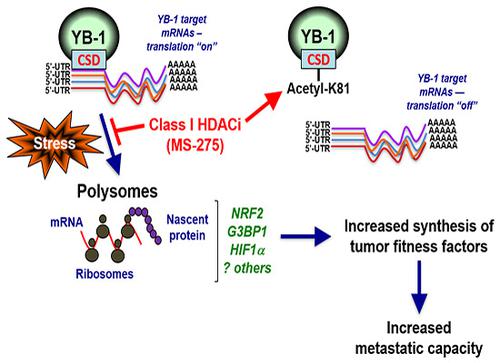Our official English website, www.x-mol.net, welcomes your
feedback! (Note: you will need to create a separate account there.)
Class I HDAC inhibitors enhance YB-1 acetylation and oxidative stress to block sarcoma metastasis.
EMBO Reports ( IF 6.5 ) Pub Date : 2019-10-31 , DOI: 10.15252/embr.201948375 Amal M El-Naggar 1, 2, 3 , Syam Prakash Somasekharan 4 , Yemin Wang 2 , Hongwei Cheng 4 , Gian Luca Negri 5 , Melvin Pan 2 , Xue Qi Wang 2 , Alberto Delaidelli 1, 2 , Bo Rafn 2 , Jordan Cran 2 , Fan Zhang 4 , Haifeng Zhang 1, 2 , Shane Colborne 5 , Martin Gleave 4 , Anna Mandinova 6 , Nancy Kedersha 7 , Christopher S Hughes 2 , Didier Surdez 8 , Olivier Delattre 8 , Yuzhuo Wang 4 , David G Huntsman 1, 2 , Gregg B Morin 5 , Poul H Sorensen 1, 2
EMBO Reports ( IF 6.5 ) Pub Date : 2019-10-31 , DOI: 10.15252/embr.201948375 Amal M El-Naggar 1, 2, 3 , Syam Prakash Somasekharan 4 , Yemin Wang 2 , Hongwei Cheng 4 , Gian Luca Negri 5 , Melvin Pan 2 , Xue Qi Wang 2 , Alberto Delaidelli 1, 2 , Bo Rafn 2 , Jordan Cran 2 , Fan Zhang 4 , Haifeng Zhang 1, 2 , Shane Colborne 5 , Martin Gleave 4 , Anna Mandinova 6 , Nancy Kedersha 7 , Christopher S Hughes 2 , Didier Surdez 8 , Olivier Delattre 8 , Yuzhuo Wang 4 , David G Huntsman 1, 2 , Gregg B Morin 5 , Poul H Sorensen 1, 2
Affiliation

|
Outcomes for metastatic Ewing sarcoma and osteosarcoma are dismal and have not changed for decades. Oxidative stress attenuates melanoma metastasis, and melanoma cells must reduce oxidative stress to metastasize. We explored this in sarcomas by screening for oxidative stress sensitizers, which identified the class I HDAC inhibitor MS-275 as enhancing vulnerability to reactive oxygen species (ROS) in sarcoma cells. Mechanistically, MS-275 inhibits YB-1 deacetylation, decreasing its binding to 5'-UTRs of NFE2L2 encoding the antioxidant factor NRF2, thereby reducing NFE2L2 translation and synthesis of NRF2 to increase cellular ROS. By global acetylomics, MS-275 promotes rapid acetylation of the YB-1 RNA-binding protein at lysine-81, blocking binding and translational activation of NFE2L2, as well as known YB-1 mRNA targets, HIF1A, and the stress granule nucleator, G3BP1. MS-275 dramatically reduces sarcoma metastasis in vivo, but an MS-275-resistant YB-1K81-to-alanine mutant restores metastatic capacity and NRF2, HIF1α, and G3BP1 synthesis in MS-275-treated mice. These studies describe a novel function for MS-275 through enhanced YB-1 acetylation, thus inhibiting YB-1 translational control of key cytoprotective factors and its pro-metastatic activity.
中文翻译:

I 类 HDAC 抑制剂可增强 YB-1 乙酰化和氧化应激,从而阻止肉瘤转移。
转移性尤文肉瘤和骨肉瘤的结果令人沮丧,并且几十年来没有改变。氧化应激减弱黑色素瘤转移,黑色素瘤细胞必须减少氧化应激才能转移。我们通过筛选氧化应激敏化剂在肉瘤中对此进行了探索,结果发现 I 类 HDAC 抑制剂 MS-275 可以增强肉瘤细胞对活性氧 (ROS) 的脆弱性。从机制上讲,MS-275 抑制 YB-1 脱乙酰化,减少其与编码抗氧化因子 NRF2 的 NFE2L2 5'-UTR 的结合,从而减少 NFE2L2 翻译和 NRF2 合成,从而增加细胞 ROS。通过全局乙酰组学,MS-275 促进 YB-1 RNA 结合蛋白赖氨酸 81 处的快速乙酰化,阻断 NFE2L2 以及已知 YB-1 mRNA 靶标、HIF1A 和应激颗粒成核剂的结合和翻译激活, G3BP1。 MS-275 显着减少体内肉瘤转移,但 MS-275 抗性 YB-1K81 丙氨酸突变体可恢复 MS-275 治疗小鼠的转移能力以及 NRF2、HIF1α 和 G3BP1 合成。这些研究描述了 MS-275 通过增强 YB-1 乙酰化的新功能,从而抑制 YB-1 对关键细胞保护因子的翻译控制及其促转移活性。
更新日期:2019-12-05
中文翻译:

I 类 HDAC 抑制剂可增强 YB-1 乙酰化和氧化应激,从而阻止肉瘤转移。
转移性尤文肉瘤和骨肉瘤的结果令人沮丧,并且几十年来没有改变。氧化应激减弱黑色素瘤转移,黑色素瘤细胞必须减少氧化应激才能转移。我们通过筛选氧化应激敏化剂在肉瘤中对此进行了探索,结果发现 I 类 HDAC 抑制剂 MS-275 可以增强肉瘤细胞对活性氧 (ROS) 的脆弱性。从机制上讲,MS-275 抑制 YB-1 脱乙酰化,减少其与编码抗氧化因子 NRF2 的 NFE2L2 5'-UTR 的结合,从而减少 NFE2L2 翻译和 NRF2 合成,从而增加细胞 ROS。通过全局乙酰组学,MS-275 促进 YB-1 RNA 结合蛋白赖氨酸 81 处的快速乙酰化,阻断 NFE2L2 以及已知 YB-1 mRNA 靶标、HIF1A 和应激颗粒成核剂的结合和翻译激活, G3BP1。 MS-275 显着减少体内肉瘤转移,但 MS-275 抗性 YB-1K81 丙氨酸突变体可恢复 MS-275 治疗小鼠的转移能力以及 NRF2、HIF1α 和 G3BP1 合成。这些研究描述了 MS-275 通过增强 YB-1 乙酰化的新功能,从而抑制 YB-1 对关键细胞保护因子的翻译控制及其促转移活性。











































 京公网安备 11010802027423号
京公网安备 11010802027423号